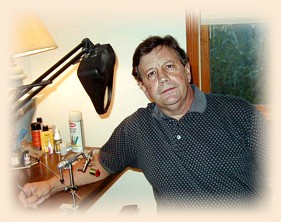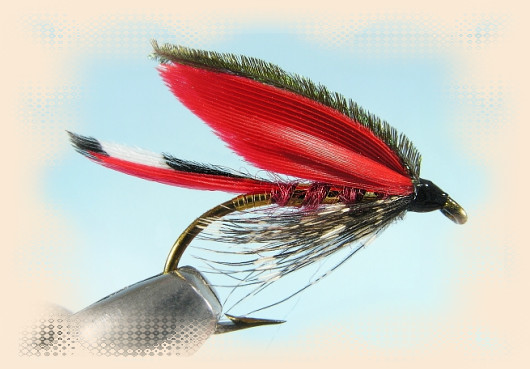This is another one from Trout by Ray Bergman.
It's a fairly difficult tie on a couple of levels. The tail
gave me fits for a bit, until I remembered that duck quill has
a great deal of "reverse" curve in the feather. If you try
to marry a left slip from a wood duck feather and a left slip
from a duck quill, you'll find that the two slips curve in opposite
directions. This makes marrying them very difficult, and wood duck
flank feathers are hard to marry anyway. There are two solutions. You
can go up high on the duck feather and harvest the slip up there, as
there is less curve the higher you go on the feather. A better fix is
to use a different feather all together, one that does not exhibit reverse
curve, such as a goose secondary or dyed turkey tail feather. I used some
turkey here that I picked up at Michael's Craft store awhile back.
An interesting feature of this fly is the peacock herl "topping", and
I tied it on just as I would a conventional golden pheasant crest topping
on a salmon fly. You'll find this tough to do at first, and it's a great
help to find herl with a natural curve similar to the top of the feather. You
can stroke the herl along the top of the wing and make it sort of
marry to it a little bit. Of course, when fishing, these herls will be kind of
all over the place anyway, and that's the point. I don't know if you've seen
the Gray Ghost streamers that have the herls on top rather than where Carrie
Stevens put them, but they are reportedly quite effective there as a trigger.
For show though, you're going to want your herls perfectly aligned with the
top of the wing, and all I can say is, good luck. It's tricky.
The guinea hackle on this one can be another source of trouble if
you don't have some guinea with very short barb length and fine stems. I didn't,
and though I typically like to wind my hackle, I used Don Bastian's "faux" hackling
on this one. You simply take a section from each side of a big guinea hackle,
match them together, and tie them on as a beard underneath the hook. It's like
tying on a flank feather wing upside down. That makes the hackling here much
easier.
J. Edson Leonard's Flies has this fly as "McAlpine", but with the
same recipe. Here it is from Bergman if you're looking for something a bit
more challenging:
McAlpin:
Credits: Trout by Ray Bergman
~ EA
About Eric:
 Eric lives in Delaware, Ohio and fishes for brown trout in
the Mad River, a beautiful spring creek. More of his flies
are on display here:
Eric lives in Delaware, Ohio and fishes for brown trout in
the Mad River, a beautiful spring creek. More of his flies
are on display here:
|


 Eric lives in Delaware, Ohio and fishes for brown trout in
the Mad River, a beautiful spring creek. More of his flies
are on display here:
Eric lives in Delaware, Ohio and fishes for brown trout in
the Mad River, a beautiful spring creek. More of his flies
are on display here: